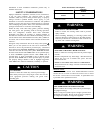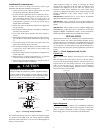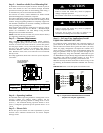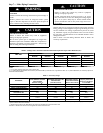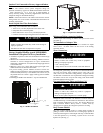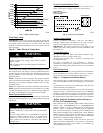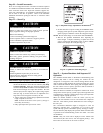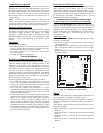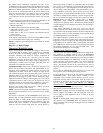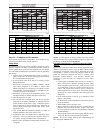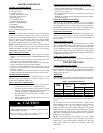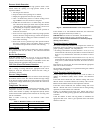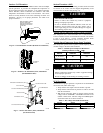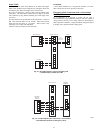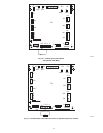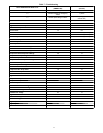
10
The control board accumulates compressor run time. As the
accumulated run time approaches the selected defrost interval time,
the control board monitors the coil temperature sensor for a defrost
demand. If a defrost demand exists, a defrost cycle will be initiated
at the end of the selected time interval. A defrost demand exists
when the coil temperature is at or below 32_F(0_C) for 4 minutes
during the interval. If the coil temperature does not reach 32_F
(0_C) within the interval, the interval timer will be reset and start
over.
S Upon initial power up the first defrost interval is defaulted to 30
minutes. Remaining intervals are at selected times.
S Defrost is only allowed to occur below 50_F(10_C) outdoor
ambient temperature.
The defrost cycle is terminated as described below.
S When OAT is > 30F(--1.1C), defrost terminatesif outdoorcoil
temperature > 50F(+10C).
S When OAT ≤ 30F(--1.1C), defrost will terminate if OCT is
>40F(+4.4C).
S Or 10 minutes has passed.
At the defrost termination, the outdoor fan output (ODF) will turn
on 15 seconds before the reversing valve switching.
NOTE: Compressor speed during defrost varies based on outdoor
conditions.
Step 13 — Check Charge
Charge in CHARGING
mode
Factory charge amount and desired subcooling are shown in the
user interface (UI). To properly check or adjust charge, conditions
must be favorable for subcooling charging in cooling mode.
Favorable conditions exist when the outdoor temperature is
between 65_F and 100_F(18_C and 38_C), and the indoor
temperature is between 70_F and 80_F(21_C and 27_C). If the
temperatures are outside of these ranges, weigh--in charge only. If
confirmation is needed return and check subcooling when the
temperatures are within the desired range.
Charging Procedure: Unit is factory charged for 15ft (4.57 m) of
lineset and for smaller rated indoor coil combinations. If any
refrigerant charge adjustment is required based on the indoor coil
combination you select and the line set length you input, the UI
will calculate and display the target subcooling and the amount of
additional charge to be added. Therefore UI is your source of
information for charging the system correctly. Refrigerant charge
adjustment amount for adding or removing 0.6 oz/ft (17.74 g/m) of
3/8 liquid line above or below 15ft (4.57 m) respectively, and an
additional amount of refrigerant charge adjustment (2 lbs) for a
large ID coil if required, is calculated and displayed by the UI.
Perform a final charge check only when in cooling and OD is
between 65F(18C) and 100F(38C).
NOTE: UI indicates acceptable conditions if outside of this range.
Do not charge if outside 65F(18C) and 100F(38C) outdoor
temperature.
If the range is acceptable, go the CHARGING screen in the user
interface (UI). At cooling conditions, set the user interface (UI) to
check the charge in cooling mode. Allow system to operate in
cooling mode for the stabilization period as indicated in the user
interface (UI). Once conditions are indicated as favorable and
stable by the user interface (UI), check the system charge by
subcooling method. Compare the subcooling taken at the liquid
service valve to the subcooling target (LiqLin SC TGT) listed on
the charging screen. Add refrigerant if the subcooling is low and
remove charge if subcooling is high. Tolerance should be 2F.
If any adjustment is necessary, add or remove the charge slowly
(no greater than 0.5 lb per minute) and allow system to operate for
15 minutes to stabilize before declaring a properly charged system.
The use of acommercial charge metering device(restrictor) such as
Imperial liquid low side charger model 535--C or Watsco
ChargeFaster model CH200 is recommended when adding
refrigerant to an operating system. This prevents potential damage
of liquid slugging of the compressor and allows the subcooling to
stabilize quicker.
If the indoor temperature is above 80_F (26.67_C), and the
outdoor temperature is in the favorable range, adjust system charge
by weight based on line length and allow the indoor temperatureto
drop to 80_F (26.67_C) before attempting to check system charge
by subcooling method as described above.
If the indoor temperature is below 70_F (21.11_C), or the outdoor
temperature is not in the favorable range, adjust charge for line set
length above or below 15ft (4.57 m) only. Charge level should then
be appropriate for the system to achieve rated capacity. The charge
level could then be checked at another time when the both indoor
and outdoor temperatures are in a more favorable range. This
ensures maximum efficiency and reliability.
Heating Check Chart Procedure
In heating mode, the required charging method is by weigh--in. On
new installation or complete recharge, refer to the REQUIRED
CHARGE CALCULATION screen in the user interface (UI) to
obtain the required charge adjustment and/or total charge required.
Use the UI and Heating Check Charts (Fig. 12 and 13) to check
system operation during heating mode. The indoor conditions
must be between 60F (15.6_C) and 80F (26.7_C) to check the
charge. The outdoor coil must be dry and ice/frost free. Do not
check for pressure agreement if the outdoor has rain, mist or snow
present.
Use the Defrost CHECKOUT mode to remove ice or frost from
coil, if present, prior to checking the heating pressures.
To use the Heating Check Chart, the user interface (UI) must be in
CHARGING mode. These charts indicate whether a correct
relationship exists between system operating pressure and air
temperature entering indoor and outdoor units. If pressure and
temperature do not match on chart, system refrigerant charge may
not be correct. DO NOT USE CHART TO
ADJUST
REFRIGERANT
CHARGE.
NOTE: High pressure is at vapor service valve. Add 12 psig if
high pressure is taken from liquid service valve.
NOTE: When charging is necessary during heating season, charge
must be weighed in accordance with unit rating plate, 0.6 oz./ft
(17.74 g/m). of 3/8--in. liquid--line above or below 15 ft (4.57
m)., respectively.
NOTE: In heating mode, check refrigerant pressures only when
user interface is in CHARGING mode and indicates stable. If
charge is in doubt, remove charge and weigh--in correct calculated
refrigerant charge.



